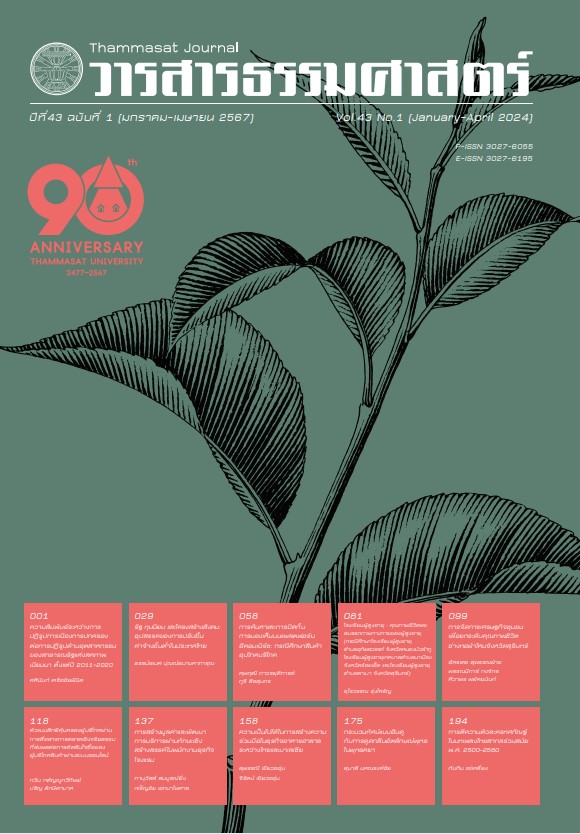The Relationship of the Political Reforms Toward the Industrial Development of Myanmar from 2011-2020
Main Article Content
Abstract
This research aims to analyze the impact of the political reforms of Myanmar on the country’s industrial development from 2011-2020. The qualitative research methodology is applied to understand Myanmar’s industrial transitions during this period by dividing them into two parts. The first part is the study of the research-related documents to understand the problems, changes, and all possible consequences. The second part involves collecting data from field research in five industrial zones in Myanmar.
The results show that during 2011-2020, Myanmar continued to prioritize state power in formulating and implementing policies to drive industrialization through economic zone and special economic zone development mechanisms. Myanmar has strengths in natural resources that can generate income for the country and an opportunity to be a strategic point connecting Southeast Asia with other regions in Asia. However, there are weaknesses of the country in using the state to lead the market, the transparency of the economic reform process, and labor productivity that is still inefficient, and the quality of human capital is low, which requires the quality of labor to be upgraded to respond to the industrial sector. Furthermore, in the post-military coup since 1 February 2021, Myanmar has been missing the key elements that have hindered industrial reform, namely political instability, and lack of political party independence. The Myanmar army has de facto power over the state and infiltrates many important organizations in various sectors of the economy. There is a lack of transparency in government organizations and state enterprises and the problem of compliance with human rights principles towards ethnic groups. If Myanmar could overcome these obstacles and challenges and try to maintain its strengths and search for existing opportunities, the country could have become a new economic hub for ASEAN.
Article Details
References
Asian Development Bank (2018). Myanmar Key Indicators for Asia and the Pacific 2018.https://data.adb.org/sites/default/files/myanmar-key-indicators-2018.pdf.
Aschauer. D. A. (1989). Is Public Infrastructure Productive? Journal of Monetary Economics, 23(2), 177-200. https://doi.org/10.1016/0304-3932(89)90047-0
Aung, S. L. (2012, September 3). The Company in Dawei. New Mandala. http://asiapacific.anu.edu.au/newmandala/2012/09/03/the-company-in-dawei/.
Bjarnegard, E. (2020). Introduction: Development Challenges in Myanmar: Political Development and Politics of Development Interwined. The European Journal of Development Research, 32(2), 255-273. https://doi.org/10.1057/s41287-020-00263-2
Day, R. H. & Zou, G. (1994). Infrastructure, restricted factor substitution and economic. Journal of Economic Behaviour and Organization, 23(2), 149–166. https://doi.org/10.1016/0167-2681(94)90064-7
Ford, M., Gillan M., & Thien H. H. (2016). From Cronyism to oligarchy? Privatization and Business Elites in Myanmar. Journal of Contemporary Asia, 46(1) 18-41. https://doi.org/10.1080/00472336.2015.1072731
Frenkel, S. & Harrod, J. (1995). Industrialization & labor relations: Contemporary Research in Seven Countries. New York: ILR Press.
JICA. (2013). A strategic urban development plan of greater Yangon. Yangon: JICA and YCDC.
JICA. (2016). Data Collection Survey on Urban Development Planning for Regional Cities: Mandalay, Pathen, Mawlamyine. Ministry of Construction (MOC), The Republic of the Union of Myanmar. https://openjicareport.jica.go.jp/pdf/12285839.pdf
JICA. (2019, October 29). Miracles of Thilawa. Japan International Cooperation Agency: https://www.jica.go.jp/myanmar/english/officeเมียนมา/topics/press191029.html
Kruaechaipinit, S. (2014). The political economy of the implement Dawei SEZ: Challenges and Opportunities for sub regional economic development. Journal of Urbanology, 5(1), 21-22.
Kumbun, J. (2019, November 6). The Keys to Building Trust and Achieving Peace Are in the Myanmar Military’s Hands. The Irrawaddy. https://www.irrawaddy.com/opinion/guest-column/keys-building-trust-achieving-peace-myanmar-militaryshands.html.
Kudo, T. (2001). Industrial development in Myanmar: Prospects and Challenges. Chiba, Japan. Institute of Developing Economies, Japan External Trade Organization (IDE-JETRO). https://www.ide.go.jp/English/Publish/Reports/Asedp/060.html
Kudo, T., Kumakai, S., & Umezaki. (2014). Five growth strategies for Myanmar: Reengagement with the global economy. Journal of Southeast Asian Economies, 31(2), 173-194.
Linn, S.N. (2014). Pilot Assessment of Industrial Zones in Myanmar. Yangon: MDRI-CESD. https://mdricesd.files.wordpress.com/2018/10/pilot-assessment-of-industrialzones-in-myanmar.pdf
Lubeigt, G.(2007).Industrial zones in Burma and Burmese labour in Thailand. Myanmar:
The state, community and the environment ANU E Press and Asia Pacific Press.
Lwin, K. W. (2019, October 13). Oil and Gas. International Trade Administration. https://www.trade.gov/knowledge-product/burma-oil-and-gas.
Lynn, T. A. & Oye, M. (2014). Natural Resources and Subnational Government of Myanmar: Key considerations for wealth sharing. The Asia Foundation. https://asiafoundation.org/resources/pdfs/NaturalResourcesandSubnationalGovernmentsinMyanmar.pdf.
Meyer, M. (2011). International Consensus: Essential Elements of Democracy. Berlin: Democracy Reporting International (DRI). https://www.concernedhistorians.org/content_files/file/to/333.pdf
Mingaladone Industrial Park. (2019). Introduction: Mingaladon Industrial Park. https://www.mingaladon.com/introduction.html
Moe Zaw Myint. (2003, December 22). New Industrial Zone in SHWEPYITHA Offers Water Transportation. Myanmar Times. https://www.burmalibrary.org/sites/burmalibrary.org/files/obl/docs2/INDUSTRIAL%20ESTATES%20IN%20MYANMAR%28EDITED%29_files/INDUSTRIES.html#A09
Myanmar Marketing Research and Development. (2015). Mandalay Investment Opportunities
Survey Report. MIC and JICA. https://myanmar-embassy-tokyo.net/eco2017/Investment/Mandalay-Investment-Survey-Report-October-2015.pdf
Nam, K. Y., Cham, M. R., & Halili, P. R. (2015). Developing Myanmar’s Information and Communication Technology Sector Toward Inclusive Growth. Manila: ASIAN Development Bank.
News Agencies. (2022, September 8). Last foreign-owned telco to quit Myanmar. Bangkok Post. https://www.bangkokpost.com/business/2387348/last-foreign-owned-telcoto-quit-myanmar.
Opperman, J. (2018, January 25). Following Dam Cancellation, Myanmar Can Lead On Sustainable Energy. Forbes. https://www.forbes.com/sites/jeffopperman/2018/01/25/following-dam-cancellation-myanmar-can-lead-on-sustainableenergy/?sh=18a5b3aa2fbe.
Perkins D. H., & Burbank, H. H. (2012). Industrial Policy Reform in Myanmar. Rajawali foundation Institute for Asia and ASH Center for Democratic Governance and Innovation, Harvard Kennedy School. https://scholar.harvard.edu/files/dperkins/files/myanmar_industrialization.pdf
PwC. (2018). Myanmar Business Guide. Yangon: Price waterhouse Coopers Myanmar Co., Ltd. https://www.pwc.com/mm/en/publications/assets/myanmar-businessguide.pdf.
Reuters Staff. (2022, January 27). Foreign companies withdrawing from Myanmar after coup. https://www.reuters.com/article/myanmar-politics-foreign-ompaniesidUSL8N2U12AI
Thana, T. T., & Thant, A. A. (2017). Challenges to Industrial Water Pricing in Mandalay Region. American Scientific Research Journal for Engineering, Technology, and Sciences (ASRJETS), 30(1), 357-371.
The Irrawaddy. (2020, November 16). Official Results Show Another Election Landslide for Myanmar’s Ruling NLD. The Irrawaddy: https://www.irrawaddy.com/elections/official-results-show-another-election-landslide-myanmars-ruling-nld.html.
Thiha. (2016, December 14). MPs to Crack Down on Brewers’ Waste Disposal. Consult-Myanmar for fruitful investment in Myanmar. https://consult-myanmar.com/2016/12/14/mps-to-crack-down-on-brewers-waste-disposal/
Thiha. (2020, February 20). Construction of Yangon expressway to start in August: Ministry. Consult-Myanmar for fruitful investment in Myanmar. https://www.consult-myanmar.com/2020/02/20/construction-of-yangon-expressway-to-startin-august-ministry/
World Bank Group. (2015). Myanmar Investment Climate Assessment: Sustaining reforms in a time of transaction. Open Knowledge Repository. https://openknowledge.worldbank.org/handle/10986/21596?show=full.
World Bank. (2017). http://databank.worldbank.org/data/download/GNIPC.pdf.
World Bank Group. (2018). The Myanmar economic monitor. World Bank Group. http://documents.worldbank.org/curated/en/986461544542633353/pdf/132847-REVISED-MEM-Final.pdf
World Bank. (2022, July 21). Myanmar Economic Monitor July 2022: Reforms Reversed. The World Bank. https://www.worldbank.org/en/country/myanmar/publication/myanmar-economic-monitor-july-2022-reforms-reversed
Zani, M. (2013, November 3). Myanmar’s Drive for Peace. The New York Times. http://www.nytimes.com/2013/11/04/opinion/myanmars-drive-for-peace.html.
Zhang, R. (2020, July 22). Chinese Investment in Myanmar: Beyond Myitsone Dam. The Diplomat. https://thediplomat.com/2020/07/chinese-investment-in-myanmarbeyond-myitsone-dam/.

